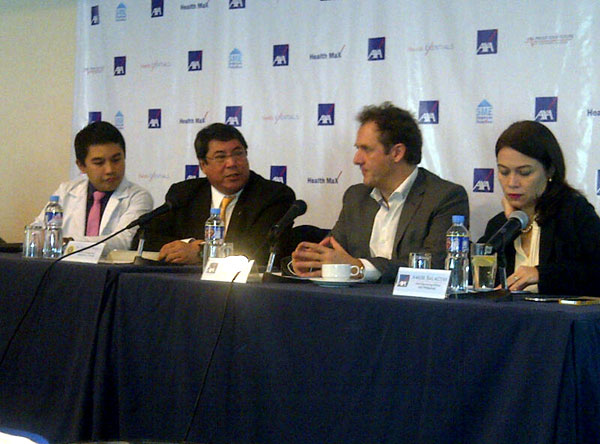Non-communicable diseases pose graver threats to Filipinos

From left to right: Dr. Renzo Guinto, DOH Undersecretary Teodoro Herbosa, AXA Philippines President Rien Hermans and Chief Marketing Officer Amor Balagtas at the AXA Health Solutions Launch Thursday in Ascott Makati. Celest R. Flores/INQUIRER.net
MANILA, Philippines — While measles are more talked about at the moment, non-communicable diseases remain graver threats for Filipinos.
Cancer, heart diseases, diabetes, hypertension, stroke or those also called “lifestyle diseases,” are still the top causes of illness and death among Filipinos today, government-collated data showed.
And the fact that these types of illnesses brought about by generally unhealthy lifestyle — smoking, drinking, lack of physical activities, among others — have no cure makes it more menacing.
“You should be scared of this more than measles. Once a child gets cured for measles, he’s immune. But there’s no immunity for lifestyle diseases,” said Department of Health Undersecretary Dr. Teodoro Herbosa at the AXA Philippines Health Solutions launch Thursday.
Lifestyle diseases are those contracted through biological, behavioral, social and environmental factors while infectious diseases like measles are spread through viruses, bacteria, fungi, etc.
“One you get hypertension, it’s chronic. There’s no cure for it. The diabetic, they never get cure. That’s why this issue on chronic diseases is probably more important than measles epidemic,” Herbosa added as cases of measles continued to rise in Metro manila.
“The problem is not measles, it’s the NCDs [non-communicable diseases].”
Citing government data, Dr. Herbosa said that 63 percent of deaths worldwide are due to smoking while 10 Filipinos die every hour due to smoke or second-hand smoke.
Lung cancer is the most prevalent type of cancer for both sexes, while breast cancer is most common for women.
Physical inactivity, meanwhile, is the fourth leading risk in global mortality, while at least 22.3 percent of Filipinos are overweight – which makes them at risk to a number of diseases.
Also according to various data presented at the press conference held at Ascott Makati, 1 out of 4 Filipinos are hypertensive, 1 out of 20 have high fasting blood sugar, and nearly 1 out of 4 are either overweight or obese.
Dr. Herbosa, who even admitted that he himself is having a hard time losing the “holiday weight,” said that one of the biggest factors in the heightened risk is lack of healthy eating habits.
Perfect examples are the Filipinos’ affinity towards “unli rice” in fast food chains, and lack of greens/vegetables or fruits, which tend to be more expensive, in a Filipino’s typical daily meal.
Stress is also a contributing factor.
When all of these factors add up, it could lead to what Dr. Herbosa called a “catastrophic illness,” where the medicals bills and other expenses take up at least 30 percent of the family’s yearly combined income and could deplete one’s savings.
That was why AXA Philippines sought DOH’s help to spread awareness about the Filipinos’ financial preparedness for health emergencies.
“We want to be able to build awareness because critical illness can hit anytime, anywhere,” said AXA Philippines’ Chief Marketing Officer Amor Balagtas.
AXA Philippines launched two new new products: Health Exentials (all-in-one health and protection plan), Health Max (maximum lifetime coverage until age of 100).